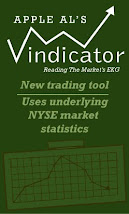The post last weekend classified the action since the lows of Mar 17 as an ending diagonal. The read at that time was that 4 legs of that structure were in place with the 5th and final leg almost complete. But this last week saw a continuation of the roller coaster. It still looks to be an ending diagonal, but one which is taking longer than thought last weekend. And just as a week ago, it appears that the 5th leg is in progress.
The alternative view would be that the waves since the Mar 17 lows are a series of waves 1 & 2 of ever declining degree, 5 in total up to this point. This would imply an upside explosion almost immediately, with a significant amount of distance in both time and price yet to come before the sequence runs out of steam. Doesn't seem reasonable, but I suppose it's possible.
---------------------------------------------------------------------------------------------------------------------------
There's been a lot of national press attention given to equities in the last few weeks as a result of the Dow Index exceeding it's all time highs of 2007 as well as the S&P being within a hair's breadth of its all time highs. So are we in the midst of a new long term bull market? There is an EW alternate that would accommodate that thought.
But the preferred view on this site is that all the action since the Mar '09 lows constitute an "X" wave. In Elliott "X" waves are moves that separate corrective sequences in complex corrections. They can travel to and even past the point where prices started the original corrective sequence. So under this view the rally of a couple of major indexes to and past the 2007 highs does not disqualify the bull run off the 2009 lows as an X wave - at least not yet.
Some perspective on the long view might help make the case. Elliott Wave distinguishes between two main wave types: impulsive and corrective. Impulse waves have 5 distinct and well defined legs, 3 in the direction of the underlying trend and 2 against it. The 3rd leg (wave) is usually the strongest and longest in equities and the 4th wave retrace does not overlap the 1st wave. Corrective waves consist of 3 wave moves or combinations of 3 wave moves. Corrective waves can be very complex and are often characterized by choppiness and a lot of price overlap.
Below are some long term charts of the S&P and the NYSE. To my eyes the action since the Mar '09 lows appears much more corrective than impulsive. But then I suppose that just proves my bearish predisposition.

















